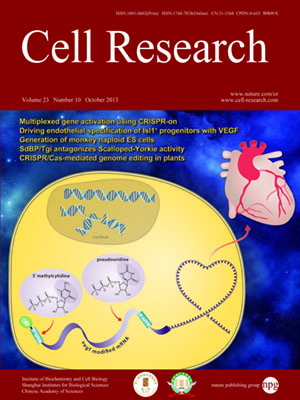
Volume 23, No 10, Oct 2013
ISSN: 1001-0602
EISSN: 1748-7838 2018
impact factor 17.848*
(Clarivate Analytics, 2019)
Volume 23 Issue 10, October 2013: 1215-1228
ORIGINAL ARTICLES
Structure analysis of FAAP24 reveals single-stranded DNA-binding activity and domain functions in DNA damage response
Yucai Wang2,*, Xiao Han1,*, Fangming Wu4,*, Justin W Leung2, Megan G Lowery5, Huong Do2, Junjie Chen2, Chaowei Shi6, Changlin Tian4,6, Lei Li2,3 and Weimin Gong1
1Laboratory of Non-coding RNA, Institute of Biophysics, Chinese Academy of Sciences, Beijing 100101, China
2Department of Experimental Radiation Oncology, The University of Texas MD Anderson Cancer Center, Houston, TX 77030, USA
3Department of Genetics, The University of Texas MD Anderson Cancer Center, Houston, TX 77030, USA
4High Magnetic Field Laboratory, Chinese Academy of Sciences, Hefei, Anhui 230031, China
5Department of Molecular Carcinogenesis, The University of Texas MD Anderson Cancer Center, Smithville, TX 78957, USA
6National Laboratory for Physical Science at Microscale, School of Life Sciences, University of Science and Technology of China, Hefei, Anhui 230026, China
Correspondence: Weimin Gong, E-mail: wgong@ibp.ac.cn; Lei Li, E-mail: leili@mdanerson.org; Changlin Tian(cltian@ustc.edu.cn)
The FANCM/FAAP24 heterodimer has distinct functions in protecting cells from complex DNA lesions such as interstrand crosslinks. These functions rely on the biochemical activity of FANCM/FAAP24 to recognize and bind to damaged DNA or stalled replication forks. However, the DNA-binding activity of this complex was not clearly defined. We investigated how FAAP24 contributes to the DNA-interacting functions of the FANCM/FAAP24 complex by acquiring the N-terminal and C-terminal solution structures of human FAAP24. Modeling of the FAAP24 structure indicates that FAAP24 may possess a high affinity toward single-stranded DNA (ssDNA). Testing of various FAAP24 mutations in vitro and in vivo validated this prediction derived from structural analyses. We found that the DNA-binding and FANCM-interacting functions of FAAP24, although both require the C-terminal (HhH)2 domain, can be distinguished by segregation-of-function mutations. These results demonstrate dual roles of FAAP24 in DNA damage response against crosslinking lesions, one through the formation of FANCM/FAAP24 heterodimer and the other via its ssDNA-binding activity required in optimized checkpoint activation.
10.1038/cr.2013.124
FULL TEXT | PDF
Browse 2424


